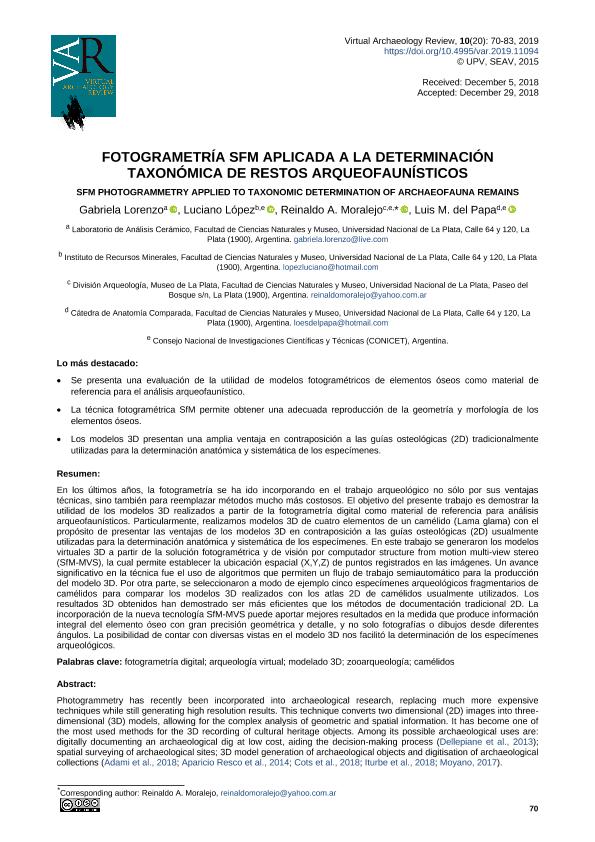Artículo
En los últimos años, la fotogrametría se ha ido incorporando en el trabajo arqueológico no sólo por sus ventajas técnicas, sino también para reemplazar métodos mucho más costosos. El objetivo del presente trabajo es demostrar la utilidad de los modelos 3D realizados a partir de la fotogrametría digital como material de referencia para análisis arqueofaunísticos. Particularmente, realizamos modelos 3D de cuatro elementos de un camélido (Lama glama) con el propósito de presentar las ventajas de los modelos 3D en contraposición a las guías osteológicas (2D) usualmente utilizadas para la determinación anatómica y sistemática de los especímenes. En este trabajo se generaron los modelos virtuales 3D a partir de la solución fotogramétrica y de visión por computador structure from motion multi-view stereo (SfM-MVS), la cual permite establecer la ubicación espacial (X,Y,Z) de puntos registrados en las imágenes. Un avance significativo en la técnica fue el uso de algoritmos que permiten un flujo de trabajo semiautomático para la producción del modelo 3D. Por otra parte, se seleccionaron a modo de ejemplo cinco especímenes arqueológicos fragmentarios de camélidos para comparar los modelos 3D realizados con los atlas 2D de camélidos usualmente utilizados. Los resultados 3D obtenidos han demostrado ser más eficientes que los métodos de documentación tradicional 2D. La incorporación de la nueva tecnología SfM-MVS puede aportar mejores resultados en la medida que produce información integral del elemento óseo con gran precisión geométrica y detalle, y no solo fotografías o dibujos desde diferentes ángulos. La posibilidad de contar con diversas vistas en el modelo 3D nos facilitó la determinación de los especímenes arqueológicos. Photogrammetry has recently been incorporated into archaeological research, replacing much more expensive techniques while still generating high resolution results. This technique converts two dimensional (2D) images into three-dimensional (3D) models, allowing for the complex analysis of geometric and spatial information. It has become one of the most used methods for the 3D recording of cultural heritage objects. Among its possible archaeological uses are: digitally documenting an archaeological dig at low cost, aiding the decision-making process (Dellepiane et al., 2013); spatial surveying of archaeological sites; 3D model generation of archaeological objects and digitisation of archaeological collections (Adami et al., 2018; Aparicio Resco et al., 2014; Cots et al., 2018; Iturbe et al., 2018; Moyano, 2017). The objective of this paper is to show the applicability of 3D models based on SfM (Structure from Motion) photogrammetry for archaeofauna analyses. We created 3D models of four camelid (Lama glama) bone elements (skull, radius-ulna, metatarsus and proximal phalange), aiming to demonstrate the advantages of 3D models over 2D osteological guides, which are usually used to perform anatomical and systematic determination of specimens. Photographs were taken with a 16 Megapixel Nikon D5100 DSLR camera mounted on a tripod, with the distance to the object ranging between 1 and 3 m and using a 50mm fixed lens. Each bone element was placed on a 1 m tall stool, with a green, high contrast background. Photographs were shot at regular intervals of 10-15º, moving in a circle. Sets of around 30 pictures were taken from three circumferences at vertical angles of 0º, 45º and 60º. In addition, some detailed and overhead shots were taken from the dorsal and ventral sides of each bone element. Each set of dorsal and ventral photos was imported to Agisoft Photoscan Professional. A workflow (Fig. 4) of alignment, tie point matching, high resolution 3D dense point cloud construction, and creation of a triangular mesh covered with a photographic texture was performed. Finally the dorsal and ventral models were aligned and merged and the 3D model was accurately scaled. In order to determine accuracy of the models, linear measurements were performed and compared to a digital gauge measurement of the physical bones, obtaining a difference of less than 0.5 mm. Furthermore, five archaeological specimens were selected to compare our 3D models with the most commonly used 2D camelid atlas (Pacheco Torres et al., 1986; Sierpe, 2015). In the particular case of archaeofaunal analyses, where anatomical and systematic determination of the specimens is the key, digital photogrammetry has proven to be more effective than traditional 2D documentation methods. This is due to the fact that 2D osteological guides based on drawings or pictures lack the necessary viewing angles to perform an adequate and complete diagnosis of the specimens. Using new technology can deliver better results, producing more comprehensive information of the bone element, with great detail and geometrical precision and not limited to pictures or drawings at particular angles. In this paper we can see how 3D modelling with SfM-MVS (Structure from Motion-Multi View Stereo) allows the observation of an element from multiple angles. The possibility of zooming and rotating the models (Figs. 6g, 6h, 7d, 8c) improves the determination of the archaeological specimens. Information on how the 3D model was produced is essential. A metadata file must include data on each bone element (anatomical and taxonomic) plus information on photographic quantity and quality. This file must also contain the software used to produce the model and the parameters and resolution of each step of the workflow (number of 3D points, mesh vertices, texture resolution and quantification of the error of the model). In short, 3D models are excellent tools for osteological guides.
Fotogrametría digital aplicada a la determinación taxonómica de restos arqueofaunísticos
Título:
SFM photogrammetry applied to taxonomic determination of archaeofauna remains
Fecha de publicación:
01/2019
Editorial:
Universitat Politècnica de València
Revista:
Virtual Archaeology Review
ISSN:
1989-9947
Idioma:
Español
Tipo de recurso:
Artículo publicado
Clasificación temática:
Resumen
Archivos asociados
Licencia
Identificadores
Colecciones
Articulos(CCT - LA PLATA)
Articulos de CTRO.CIENTIFICO TECNOL.CONICET - LA PLATA
Articulos de CTRO.CIENTIFICO TECNOL.CONICET - LA PLATA
Citación
Lorenzo, Gabriela Soledad; López, Luciano; Moralejo, Reinaldo Andres; del Papa, Luis Manuel; Fotogrametría digital aplicada a la determinación taxonómica de restos arqueofaunísticos; Universitat Politècnica de València; Virtual Archaeology Review; 10; 20; 1-2019; 70-83
Compartir
Altmétricas




